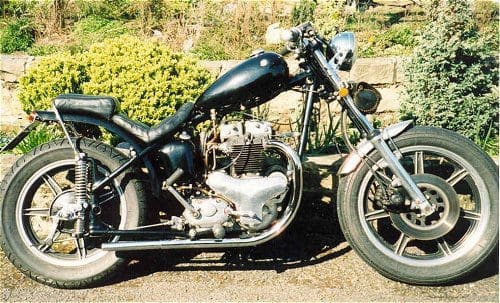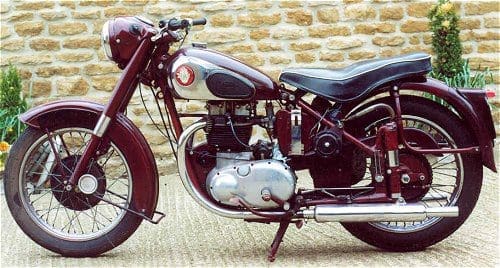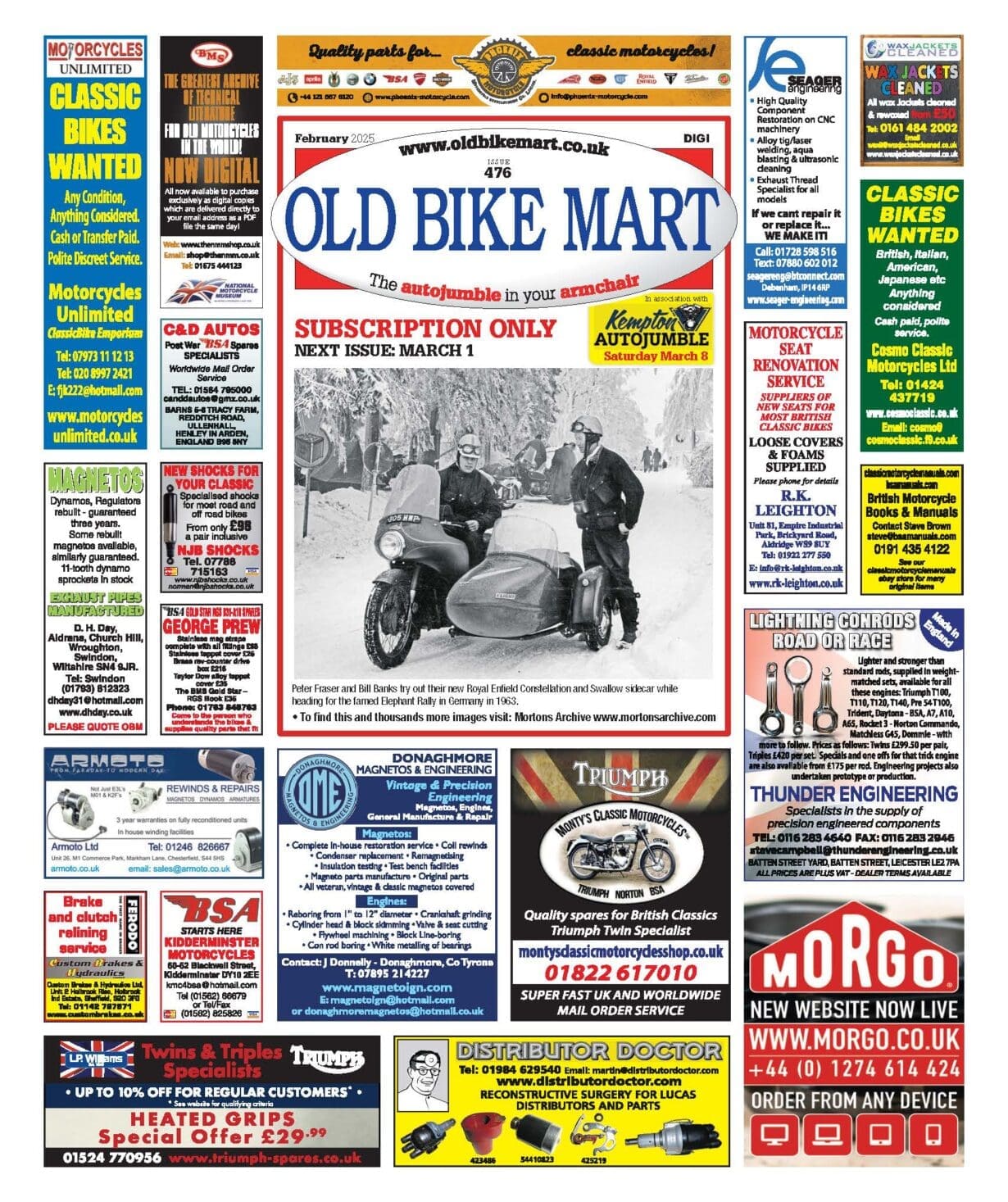BSA’s smaller twins are often overlooked, while the 650s grab all the attention. Steve Bergman cast a modern bike rider’s eye over the A7 and its emulators…
During those irritating times when The Empire wasn’t at war with someone and the market for weapons was poor, the Birmingham Small Arms Company, or BSA to you and me, turned its attention to motorcycles. Which is why the BSA A7 500cc twin has its origin just before World War 2 but didn’t appear until later. BSA even managed to reach an advanced state of development before turning their attention to rifles with which to shoot at the Hun. So while the other side got those ace BMW outfits to ride around on, and Steve McQueen got a solo stunt version, poor old Tommy had to wait. In fact Tommy had to wait until 1946 for the A7 production to go ahead.

With 62mm diameter pistons travelling at some 60mph up and down a stroke of 82mm, the 495ccs of the A7 engine is real lazy by today’s standard. But then again, whilst it only chucked out 26bhp at 6000rpm, the torque was available in plenty at almost every part of the engine rev range — thus giving a chap an easy 85mph.
|
In 1952 three BSA A7s were entered for the Maudes Trophy and they toured Europe and entered the International Six Days Trial. That culminated in 4500 trouble free miles which may not be very impressive these days but was very impressive then. Crikey, even Triumph seemed not able to do it in the 1970s! Not to mention Honda’s famous self destruct overhead cams. Mind you white metal engine bearings ensured regular engine rebuilds at some 25,000 to 30,000 miles. In fact that is something both the A7 and the rifles which BSA produced had in common. They both went bang! In 1954 the swinging arm model was introduced and changes were made to the engine, reducing the stroke to 72.6mm and increasing the bore to 66mm, giving a slight increase in capacity. The test bike I rode, a late one, had covered some 100,000 miles over the last 32 years in the hands of its present owner and has had its 25,000 mile blow-up engine rebuilds as regular as clockwork — that’s happened four times! You could go for the bearing conversion to fix this, but it is expensive. Having said that, the A7 engine really is a doddle to work on. The minor exception being when you get to the pushrods, which have to be fitted up into the rocker box cover which is one unit. This can be difficult but a special tool is available. |
In 1952 three BSA A7s were entered for the Maudes Trophy and they toured Europe and entered the International Six Days Trial. That culminated in 4500 trouble free miles which may not be very impressive these days but was very impressive then. Crikey, even Triumph seemed not able to do it in the 1970s! Not to mention Honda’s famous self destruct overhead cams. Mind you white metal engine bearings ensured regular engine rebuilds at some 25,000 to 30,000 miles. In fact that is something both the A7 and the rifles which BSA produced had in common. They both went bang!
In 1954 the swinging arm model was introduced and changes were made to the engine, reducing the stroke to 72.6mm and increasing the bore to 66mm, giving a slight increase in capacity.
The test bike I rode, a late one, had covered some 100,000 miles over the last 32 years in the hands of its present owner and has had its 25,000 mile blow-up engine rebuilds as regular as clockwork — that’s happened four times! You could go for the bearing conversion to fix this, but it is expensive. Having said that, the A7 engine really is a doddle to work on. The minor exception being when you get to the pushrods, which have to be fitted up into the rocker box cover which is one unit. This can be difficult but a special tool is available.
Regular servicing is at 1500 miles. This should include an oil change and a check on the valve clearances. A useful thing here is to bend the end of your feeler gauge over at an angle to enable easy checks to be made. Oh, the sheer joy of technology! Plugs and points are on 3000 mile intervals but you’ll probably want to tinker with it before then. Engine oil on the A7 is carried in a separate tank. They call it dry sump. They could have called it wet tank. But they didn’t… A useful conversion can be fitted to the return oil feed to the tank, consisting of a screw-on cartridge oil filter. Makes those bearings last a bit longer.

You will find the A7 comfortable and easy to ride though, like most bikes the further you go the harder the seat gets. You get the usual numb bum at 100 miles. Riding with a pillion will reduce this further and isn’t particularly recommended as there isn’t acres of seat space. The handling is very predictable and there are no surprises. In fact the A7 is capable of maintaining a high average on the highways and byways but not really recommended for motorway use. But then to use a bike like this on a motorway is to totally miss the point — though with totally intrusive vibration at motorway speeds you would probably only try it once.
The A7 is fitted with a four gallon (18 litre) petrol tank. With fuel consumption in the region of 55 to 65mpg, giving a range of 220 to 260 miles, and the pleasant exhaust note you should be chucking your throw-overs on or your rucksack, and taking to the old, now unmarked, pre-bypass roads. These are quite strange to use for the uninitiated. It involves travelling through places and makes an interesting change from the usual journey where you travel the length and breadth of the country along bypasses — thus not actually going anywhere but travelling everywhere. On an A7 you can stop frequently to take in the views and chat to the old git who’s just wandered up to tell you he ‘used to have one of these in the old days’ and ‘they don’t make ’em like this any more do they’. But then it’s worth listening to the old chap if only to get invited back for some homemade cake and a real cup of tea.
And you can ride around Britain without changing the tyres halfway. Its true, most modern plastic fantastics couldn’t go once around the coast of Britain without a pit stop for new rubber. The A7 needs a 3.50 x 19 rear tyre every 10,000 miles, and a front 3.25 x 19 tyre every 15,000 miles. Eat your heart out R1 owners! But remember these are tubed tyres on spoked wheels which have the ability to give you character building experiences should you get a puncture. Mind you, if you survive at least you can fix them at the side of the road using a bicycle puncture repair outfit from the nearest Halfords. It’s probably not worth taking the tube with the hole to ‘Easy Rip Off Tyres’ down the local high street as the young lads inside will just look at you gone out.
Night time riding will be severely restricted due to the 6-volt electrics coupled to a 45-watt headlamp. It’s not that you couldn’t see where you were going; it’s more a case that modern lights are so much better so the lights from traffic coming ahead will totally overwhelm yours. The answer? Park up early and go to the pub. Why do you want to ride at night anyway? It’s all dark — no scenery! A simple 60-watt generator charges the battery through a equally simple voltage regulator, almost identical to those used on the early 6-volt MZs and can be used on the A7. In an emergency the contact breakers can be adjusted shut to give continuous charge or open for none at all.
Seven inch (175mm) drum brakes back and front sound really scary but in reality are quite adequate. No caliper seizures either. Oil consumption of 250-300 miles per pint completes the not-so green picture. I know modern stuff doesn’t normally use it, but they did back in the good old bad old days. So its ‘fill ‘er up guv and I’ll be having a pint of oil too mate’.

After 16 years, production of the A7 ceased in 1962… but that isn’t the end of this story.
Over in Japan someone else in a company called Megura was obviously impressed with the A7. They went into production with their K-1 model which was about as close to an A7 as you could get without being an A7. It even had the same bore and stroke of 66mm x 72.6mm. Then Kawasaki took over Megura and continued to make the K-1, but in a bored out format calling it the W-3. By now we had moved on to 53bhp and 105mph. The last Kawasaki W-3 was made in 1976.
So what do you do if you fancy the laidback lifestyle that goes with an old Brit iron like the A7, but don’t fancy the character-building exercises associated with running old classic bikes? Getting hold of a Megura or W-3 Kawasaki would be even more hassle. Heaven knows what your local shift-the-metal dealer would make of a parts request. The answer lies back with Kawasaki.
This time they decided to go for the old Triumph lookalike and called it the W650. You’ll have seen it talked about on the RealClassic message board plenty of times already, even if you haven’t read Jonny Wellard’s story about his. Let’s make it very clear. At 100 paces you could mistake this bike for an old Triumph. The pre-Bloor type. It even has an air-cooled parallel twin engine!
But the comparison ends there. The 676cc 4-valves per cylinder engine knocks out some 50bhp and delivers it via a 5-speed gearbox. Which should propel the 427lbs (194kg) along at a respectable speed. The two year warranty underlines what we expect with regard to reliability today. (So no problems expected with self destruct white metal bearings…).
You even get twin shocks at the rear end and almost ‘period’ wheel sizes of 100/90 x 19 at the front and 130/80 x 18 at the back. Which is useful even if it only means 18 and 19-inch tyres are now available in a larger range, thus benefiting older bike owners. A single disc up front and a drum brake at the rear complete the picture.
So now you can buy your lifestyle without the hassle of being in the real world. Despite not saying ‘Triumph’ or even ‘BSA’ on the petrol tank, the W650 has now been in production for nearly four years, and while new ones still cost around £5000 in the UK, you can pick up an early secondhand one for about £2700; much the same as a well-presented, show-stopping A7. What price history?

What price history indeed? Read the ongoing debate here.



